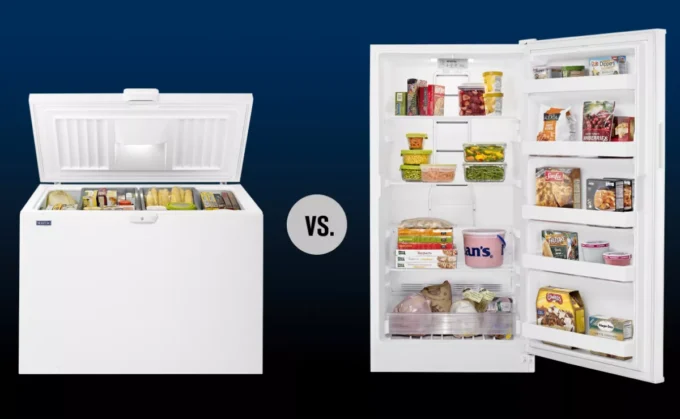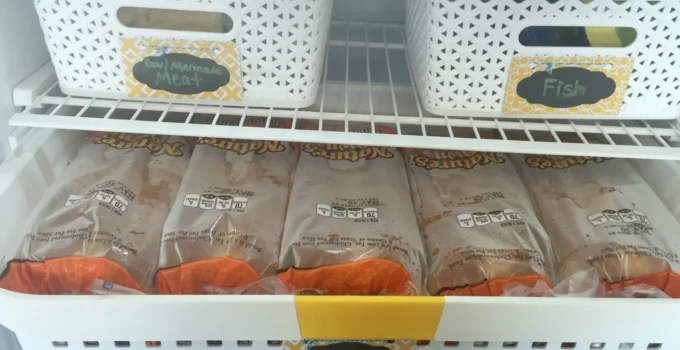A vertical freezer, also known as an upright freezer, is a household appliance designed for the storage of frozen food and other items. Unlike traditional chest freezers, vertical freezers are designed to stand upright and typically feature shelves, drawers, and compartments for organising and accessing frozen goods. In this article, we will explore some of the ways to organise your vertical freezer and how it can be a valuable addition to any home or commercial kitchen.
Let us now discuss the ways we can organise vertical freezers.
How to organise your vertical freezer?

Source: countrylivinginacariboovalley.com
Organising your vertical freezer efficiently is essential to make the most of the available space, keep track of your frozen items, and maintain the quality of your food. Here’s a step-by-step guide on how to organise your vertical freezer:
1. Empty and Clean:
Starting with an empty and clean freezer is the foundation of a well-organised freezer. Removing all items allows you to thoroughly clean the interior, eliminating any potential contaminants. Ice buildup should be thawed if present, and cleaning with warm, soapy water helps remove any remaining odours or residues. Make sure to dry the interior completely to prevent ice formation and maintain the freezer’s efficiency.
2. Categorise Your Items:
Categorising your frozen items is a crucial step in freezer organisation. Grouping similar items together makes it easier to locate what you need and minimises the time spent searching for specific items. Common categories include meats, poultry, seafood, vegetables, fruits, prepared meals, and desserts. This step lays the foundation for efficient organisation.
3. Use Storage Containers:
Investing in quality freezer-safe containers or bags is key to preserving the quality of your frozen food. These containers prevent freezer burn, maintain food freshness, and prevent odours from mingling. Be sure to label containers with both the date and contents, ensuring you can identify items quickly without needing to open every container.
4. Utilise Shelves and Drawers:
Vertical freezers come with shelves and drawers that should be maximised for efficient storage. Reserve the top shelves for frequently accessed items, like frozen fruits and vegetables, as this minimises the need to bend down. Use lower shelves or drawers for items you don’t need to access as often, such as meats or bulk items, making it easier to access these categories when needed.
5. Follow FIFO (First-In, First-Out):
The FIFO principle is an effective strategy to reduce food waste. By placing newer items at the back and older items at the front of your freezer, you ensure that you use items in the order they were frozen. This practice prevents older items from getting forgotten and ensures that everything is used before reaching its expiration date.
6. Group Similar Items:
Grouping similar items together is a simple but effective way to streamline your freezer. By placing all frozen meats in one section, vegetables in another, and prepared meals in yet another, you can easily locate items without sifting through a jumble of different products. This method saves you time and reduces the risk of freezer clutter.
7. Use Transparent Containers:
Transparent containers or bags provide a visual advantage. Being able to see the contents without opening the container makes it quick and easy to find what you’re looking for. This transparency can be especially helpful when you have multiple items of similar appearance, like different types of soups or stews.
8. Label and Date:
Labelling containers with contents and dates is a proactive approach to organisation. This step helps you identify items at a glance, especially if you have multiple containers with similar-looking contents. It also prevents the use of items that might have been in the freezer for an extended period and may have deteriorated in quality.
9. Don’t Overload:
Overloading your freezer can hinder its efficiency and access to items. Restricting airflow can lead to uneven cooling and potentially cause items near the back to freeze together, making them harder to separate. It’s essential to maintain some open space within the freezer for proper air circulation and ease of use.
10. Regularly Rotate and Check:
Periodic rotation of items ensures that older items are used before newer ones, reducing the risk of food waste. It also gives you an opportunity to check the condition of items in your freezer, ensuring they remain safe to consume.
11. Keep an Inventory List:
Maintaining an inventory list, whether on paper or through a digital app, is a proactive approach to freezer organisation. An inventory list helps you keep track of what’s in your freezer, preventing duplication and allowing you to plan meals more effectively. It’s an excellent tool for staying organised and making the most of your freezer space.
Additional tips to follow
Source: thespruce.com-
Freeze Flat:
Whenever possible, freeze items flat in a single layer before stacking or storing them in containers. This makes it easier to stack and access items, and it maximises the use of space.
-
Utilise Color-Coding:
Use color-coding to quickly identify categories or expiration dates. For example, you can use coloured labels or markers to indicate the month an item was frozen, making it easy to spot older items.
-
Vacuum Seal Foods:
Vacuum-sealed bags or containers are excellent for preventing freezer burn and preserving the quality of your food. They also save space as they can be compactly stored.
-
Organise by Cooking Method:
Group items by cooking method. For instance, store all ingredients for slow cooker meals together, or place items suitable for grilling in one section. This helps streamline meal preparation.
-
Keep a Defrosting Schedule:
Regularly defrost your freezer to maintain its efficiency. Follow the manufacturer’s recommendations for defrosting, and use this as an opportunity to reorganise and clean.
Conclusion

Source: maytag.com
In conclusion, following the organisation steps and incorporating these strategies into your freezer organisation routine, you can not only save time and reduce food waste but also make your frozen food storage an efficient and stress-free experience. A well-organised vertical freezer is an asset to your kitchen, helping you make the most of the food you store and ensuring that it remains fresh and readily accessible.






